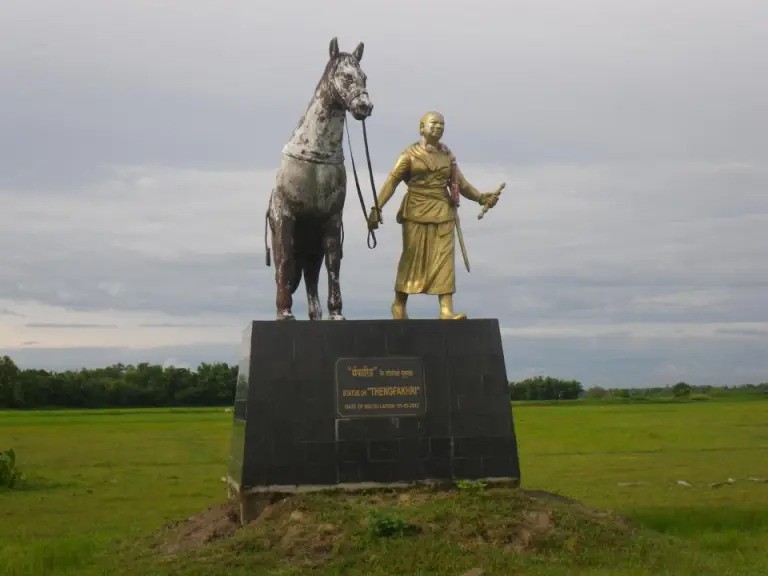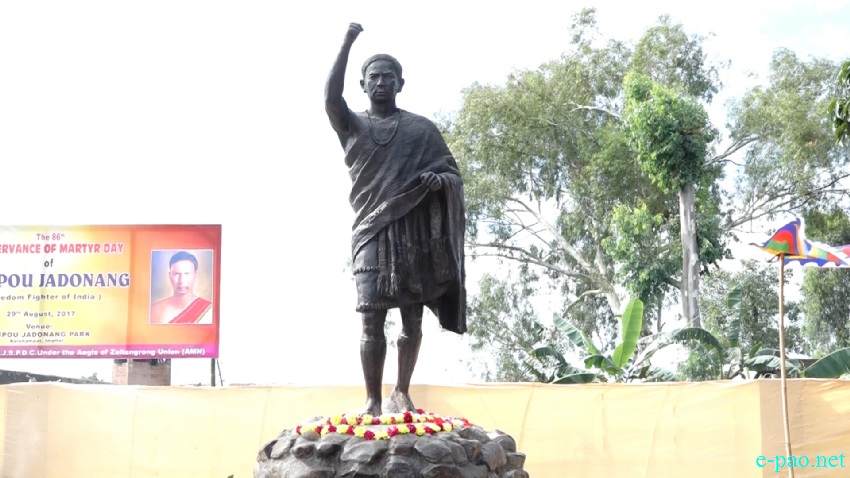By Dr. Banabina Brahma,
Abstract:- The history of Indian freedom struggle would be incomplete without mentioning the contributions of women of this land. The sacrifices made by the women would occupy foremost place. They fought with true spirit and undaunted courage and faced various tortures, exploitations and hardships to earn us freedom.
The period from 1757 to 1856 was an era of expansion and consolidation of colonial rule in India. This period saw the major changes in socio-political and economic structures of India. These changes did not go unchallenged. This paper tries to explore the resistance of the courageous Bodo Woman known as “Thengphakri”, against the oppression and brutal revenue collecting system of British. This is an untold history of a unique woman braveheart with a nationalistic approach who died to challenge the mighty British colonists in 1856 where most women in mainland India were still under purdah system and followed Sati system.
Introduction:- The country achieved independence on August 15, 1947, following numerous movements and struggles. This effort included the historic uprising of 1857, which was led by both well-known and many unknown heroes during the 200 years of struggle for independence. This independence was achieved through the efforts of many revolutionary freedom fighters, who took the lead in organizing the struggle which led to India’s independence. Although, they were of varied ideologies, their contribution to India’s struggle has been immortalized in the minds of every Indian. Some are known in history and some are unknown. In documenting the struggle against the British, however, some freedom fighter from the North East, specially from Assam has not found its due place in popular discourse.
“Thengphakri” alias “Birgwshri Sikhla” was such an unknown hero of Indian Freedom Movement from Bodo tribe of Assam. She was born in 1810 at the Eastern Duars under the Bijni Raj Eastate. She was strong, courageous and intelligent from her childhood. She was appointed as the ‘Tehsildar’ or the revenue collector at the age of 32 by the British. In fact, she was the first female ‘Tehsildar’ appointed by the British in India. At first, she was appointed as the Irazdar of Sankosh, Manash, and Buridiya Ghat in 1842 but by dint of her sincerity, honesty and loyalty to the British, she was upgraded to the post of Tehsildar in 1845.
Research Methodology: To write this paper, an amalgamation of three of the social research tools were applied as they are authentic and brilliant method to assemble statistic from multiple sources in a methodical and convenient way - (i) Archival Source, (ii) Folklore & Folktale and (iii) Interviews of senior citizen who possessed the knowledge of history and folklore of Bodos.
Objective of the research paper:
The main objectives of this paper are:
In depth study and bring into focus of individual Women Freedom fighter who fought for our freedom against British which has remained untold so far.
Tengphakri was a loyal British officer but after the death of her uncle Priyo Musahary, who was a revolutionist, she was shaken and vowed to fight against the British till her death. But before going into the details of the fascinating story of Thengpakri becoming a British Revenue Collector and her fight against the British we must know the history of Eastern Duars.
The “Eastern Duars” holds an important place in the history of Assam as well as in Indian History because of its typical geographical position. The entire tract called ‘Eastern Duars’ is the only connecting link between the entire Northeastern regions with the rest of the Indian Republic.
The terms ‘Duars’ literally means ‘ door’ in English is used to refer the areas below the foothills which always carried the sense of border mart at the foot of mountain pass and the areas in its immediate vicinity. Duars therefore means the passes and valleys that led to the hills. It is known to all that social relation and economic interdependence between the hills and the plains of Northeast India have been there since the time immemorial. It is through this Duars that the people of Bhutan have been interacting with the plains people below their foothills since time immemorial. Along the indo Bhutan borderline, there are eighteen such Duars or passes on the frontier of Bengal and Coch-Bihar are together called ‘Western Duars’ and the remaining and seven on the Assam are called the ‘Eastern Duars’.
The tract called “Eastern Duars” forms an integral portion of undivided Goalpara, Kamrup and Darrang District of Assam. The Eastern comprises several Duars. In the Duars, covering the narrow strip of the plains, that is, the foot hills providing access to the mountain region compressed within the limits of Assam there are 14 Duars; of these, five Duars, viz., Bijni or Bagh Duar, Chirang, Guma, Ripu and Sidli, collectively known as Eastern Duars, are situated in between the river Manash on the east and the Sankoch on the west. Five other Duars, viz., Baksa, Bijni, Chapaguri, Chapakhamar and Garkhola are situated between the river Bamadi on the east and the Manash on the west. The remaining three Duars, viz., Buriguma, Killing and Koreapara are situated between the Dhansiri on the east and the Bamadi on the west and Chariduar, situated further east. Koreapara is now situated in the present Kameng district of Arunachal Pradesh and Chariduar is included in the present Darrang district of Assam. The Eastern Duars form a flat strip of country lying beneath the Bhutan Mountains. It is bounded on the North by the mountain of Bhutan, on the East by the River Manas, separating it from the district of Kamrup, on South by the main portion of Goalpara district and on the West by the River Gangadhar and Sankash, which separates it from the Western Duars attached to the Jalpaiguri district of North Bengal.
Political History
The political History of Eastern Duars is very peculiar. It had been ruled by different dynasties in different period. In the ancient period, it was under the rule of Kamrupa Kingdom. After the disintegration of the Kamrupa Kingdom, it came under the Koch Kingdom. Again in seventeen century, the Mughals occupied the eastern part of Koch Kingdom. Finally, the Ahoms defeated the Mughals and the Ahoms established their control over this area. But the Ahom could not consolidate their rule over this area because of the Meches (Bodos under the banner of the Raja of Bijni, the Raja of Sidli and the Raja of Darrang) had resented the Ahom rule and tried to assert independence with help of the Dharma Raja of Bhutan. In such circumstances, the Ahoms were compelled to enter into a compromise with them and accordingly ceded the Duars region to the Dharma Raja of Bhutan in exchange of some tribute. With that the hope of independence of the Bodos over alien rule has died, so far it was the first collective effort of the Bodo Chiefs of the Duars region to ascertain independence over alien rule. Now they have put under the Dharma Raja of Bhutan. The Dharma Raja could realize the fact that at any time the Bodos could try to overthrow his rule from the Duars plains; he adopted a very diplomatic policy towards the chief of Bijni, Sidli and Darrang. Instead of over lordship towards those Rajas; Bhutan’s attitude was that of friendly and equality. These were allowed to collect revenue freely without any influence from the Dharma Raja. The Rajas were assisted in revenue collection with some ‘Subbhas’ or ‘Choudharies’ who were mostly the Bodos and were directly appointed by the Dharma Raja himself. The policy of equality adopted by the Dharma Raja of Bhutan had proved to be fruitful in the long run.
With the occupant Assam in 1826 by the British, the Duars also came under the subjugation. The British tried to maintain the old arrangement but the Bhutias were alert in establishing the rights in the area; the amount of which they paid to the Ahoms was increased which the Bhutanese did not care to clear off. It is for non-payment of tribute and the Bhutia’s atrocity on the plain people of Assam, the Duars occasionally arrested and finally in 1841, the Kamrup and Darrang Duars were annexed by the British, and they agreed to pay Bhutan authority a sum of 10,000 annually as compensation for the loss of revenue from Duars.
The company authority in their anxiety to exercise their political control over the Bhutanese and to promote their trade and popularize European goods officially organized annual trade fairs at a number of places at the border. In addition to the people on the both sides of the frontier, the Europeans, Marwaris, Chinese and Tibetans attended these fairs that were organized in the winter season. Although the official fairs were for three days, the actual trade usually continued from January to March. Along with the trade fair, various cultural and sport events were held where the local people participated enthusiastically. It was in such a sports event, Thengphakri was noticed by the British because of her strength and skill in defeating the opponent. She was inducted by British in 1842 and then she was promoted to Tashldar in 1846 for collection of revenue in Birjahar Dihi.
Thengphakri was physically strong and a expert horse rider. She rode to various remote places of erstwhile Bijni estate to collect revenue for the British. She was contemporary to Rani Abhoyeswari of Bijni kingdom and both of had a cordial relationship. But at that time situation were changing rapidly in mainland India. An wave of anti-British feeling had spread all over India. It has touched nearby Bengal too. The British were introducing new taxation policies all over India for massive revenue collection in Assam too, they introduced new revenue policy. This new revenue policy was disastrous to both social & economic life of the people of Assam. Land revenue was increased. They extracted revenue by prohibiting community fishing and fire wood collection which were common in Assam. They have introduced ploughing taxes, grazing taxes but did nothing to improve the condition of farmers. This was resented very much by the people. Anti British wave spread out amongst the Maniram Diwan and Phiyoli Phukan from Assam established an contact with sepoy Mutineers in Bengal and tried to establish the last Ahom Monarchy in Assam, but did not succeed.
Thengphakri through Rani Abhoyeswari of Bijni kindon came in contact with the aids of Moniram Dewan. By then she had already realized about the devastating effect of British rule and their ever increasing taxation policy. She protested against the new taxation policy, but was paid no attention. The plight of her own kin’s & people made her rebellious.
At the same time whole country was witnessing spread of nationalism and resentment against the foreign rule. In some parts of India agitation had started against the British. The Indian sepoys under British were resenting over non-payment of their overseas dues. The Mughal empire was declining. At this juncture, the Sepoys prepared mutiny against the British under the leadership of Rani Laxmibai and Bahadur Shah Zafar. In Assam Moniram Dewan came into contact with the Sepoys in Culcutta and tried to bring the mutiny in Assam. At the same time a war broke out between Bhutan & British over the control of the Duars region in 1864. Taking the chance, “Thengphakri and some of her loyals tried to over throw the foreign rule from Easter Duars. And finally after the death of her uncle Priyo Mushahary, she had decided not to work under the oppressive British anymore and rebelled against them. She fled to jungle with some of her fellow sepahis and arms & ammunition that was provided to hem by the British. She declared war on the British and started guerrilla warfare. She became hero of he people and her followers increased day by day. She challenged the mighty British empire by her velour and courage. But finally her all followers were brutally killed or captured and Thengkari herself was killed by the British in 1865 at the foothills of Birjhar Hill.
Thengphakri’s fascinating story of heroism and supreme sacrifice finds no mention in history or other documents. If it survives today, it is mainly in local legends, folklore and two novels written by Gyanopeeth awardee and famous Ramayani Scholar Dr.Mamoni Raisom Goswami’s last novel ‘Thengphakri Tehsildaror Tamor Torowal’ and and Sri Bidyasagar Narzary’s Sahitya Academy award winning novel in Bodo language ‘ Birgwshri ni Tungri’. There are several papers written on Thengphakri by scholars on several times. Amongst them, the most prominent are Dr.Prasun Barman of Cotton University, in his paper-“Birangona Thengphakri’r Sondhanot’ and Dr. Jiten das on his paper ‘Thengphakri Tetiya Tehsildar Nasil’ and so on.
Going through these scattered resources, we find the picture of a woman who made a pivotal contribution to the 1857 Sepoy Mutiny at the forfeit, who fought bravely against the British in 1865 during the Anglo-Bhutan war and was killed by the British at Birjhora Hills
Why is history silent?
The name of Thengphakri has not found a mention in any historical chronicle. Oral traditions are in abundance revolving around Thengphakri, about her patriotic values and sacrifices among the Bodos. The answer to the questions of history’s silence on Thengphakri lies on the following hypothesis: Thengphakri though she was a loyal servant of the British at the beginning, but after her uncle Priyo Musahary’s death, she was infused with patriotism and went against the British. She fought against the British. So, in the good book of the British she was an offender and a traitor. As a result, the people became tight lipped about her. She did not find mention in the history of colonial India. On the contrary, popular legends started growing around among the Bodos about the heroism and supreme sacrifices of Thengphakri.
Conclusion: -
Thengphakri was a very strong and able local administrator and tax collector. Her patriotism and heroism have to be brought to light in true historical perspective. The story of Thengphakri’s participation in the Indian freedom struggle is the story of bold choice against injustice meted out by the British. On the auspicious occasion of celebrating Azadi-Ki-Amrit-Mahatsov, it would be most befitting gesture on our part to pay homage to this great daughters of mother India who fought and contributed enormously to the success of our freedom struggle and all other nation building activities.
References:
Ashley Eden: Report on the state of Bootan and the progress of the Mission of 1863-64, in ‘Political Missions to Bootan’. Asian Education Services’ New Delhi, 2001. P.9.
Major F C Hirst and A B Smart: A Brief History of Surveys of the Goalpara District. Assam Secretariat Press. Shillong, 1917. P.1.
A. J. Laine: An Account of the Land Tenure System of Goalpara. Assam Secretariat Press. Shillong, 1917. P.4.
H. Luttaman- Johnson: Land Revenue: Administration Report of Assam Valley Districts or the year 1890-91. Assam Secretariat Press. Shillong, 1891, p.56-57 .
In the Court of the Deputy Commissioner and Subjudge of Goalpara (Civil Original suit no.10 of 1887). In ‘Statement of the Case on behalf of Moharaja Kumar Vivtor N. Narin for Succession to Bijni Eastate’ State Archives. Guwahati. P.1
Goswami Mamoni Roisam: The bronze sword of Thengphakri Tehsildar. Joytiprakason. Guwahati, 2009.
Nazary Vidyasagar: “ Birgwshri ni Thungri”. GBD Publication, Guwahai, 2007.
Das DR. Jiten: “Thengphakri tetia Tehshildar Nasil”. Amar Axom, Guwahati, 4th july,2010. P.6.
Barman Dr. Prosun: “Birangona Thengphakrir sondhanot”, The Heritage, (Multi-lingual Research Journal on Indology, vol-XI, Issue-2,2020)
(The author of this article is a faculty member of Kokrajhar Govt. College, Assam)






